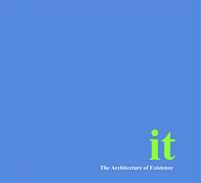"'It' is all things to all people yet has no specific meaning except as suggested by the context within which the term is used. In so being, 'it' conveys the secular equivalence of omnipresent existence - a word in a world connoting a world in a word."

 |
It: The Architecture of Existence by Gary Hansen Janus Publishing Company
book review by Wendy Strain
From the first line of this lengthy text, the reader is aware that they are embarking on a journey of philosophical introspection regarding the nature of human understanding. At more than 800 pages, no one would consider reading through this text quickly an option, but even reading through the short (less than 20 pages) essays will take more time than anticipated.
This volume is the collection of Hansen's four volume set published under the same title plus an introductory section to put everything in context. Each volume is itself a collection of 50-60 inter-related essays grouped around a common theme. These major themes include Relations, Intellect, Volition, and Affections. To get a sense of how this works, a brief look through the contents reveals an outline of major concepts discussed. Relations, for example, starts with essays entitled "Existence: Durable Being," "Essence: Quality Intrinsic to Existence," and "State: Condition."
The architect's mind at work is clearly evident in the careful construction of this text, allowing each idea to build on another with a solid structural base and an obvious inter-connectedness of elements, all displayed in beautiful symmetry. This obvious inter-connectedness is what gives this book its unique accessibility.
While it is possible to read the text from cover to cover, the author subtly suggests a better way to use it in his reference to Peter Roget and his construction of the Thesaurus of English Words and Phrases in 1852. The author commends Roget for recognizing "that the classification of ideas is the true basis on which words, which are their symbols, should be classified. So the form and contents of this treatise have been conditioned and afford a modest basis for mind-to-mind comparison."
When a thought occurs, it is quite easy to pick up the text and, with a quick check in the extensive contents, find an article that discusses an idea such as Freedom on page 503. After reading the 3-page essay, you may feel compelled to move linearly forward to Dependence or you may instead choose to chase your original thought down by looking more deeply into Consent or Agreement much in the same way you might chase down a specific meaning of a word by jumping about in the thesaurus.
Each of the essays included in the text is capable of standing on its own, so it is not necessary to understand everything that has gone before. Sentences have a tendency to go long, but they are followed by more relatable narrative to assist with processing. The relative brevity of each section leaves plenty of room for personal introspection while the structure, as already discussed, enables a completely personal experience that changes each time the book is picked up. In case the contents don't point you directly where you wish to go, a thorough index is offered providing even greater direction.
Although the content is deep, the tone is conversational, easily relating itself to more concrete analogies to increase understanding. Hansen also includes witty comments that make the text enjoyable, less like a textbook and more like a philosophical conversation among old friends.
RECOMMENDED by the US Review
NOTE: The second edition has been retitled as Exploring Existence.